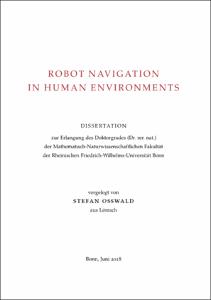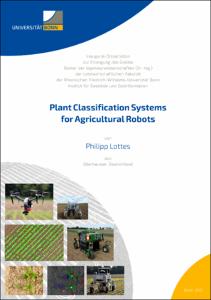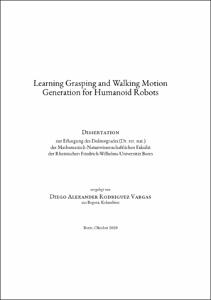Oßwald, Stefan: Robot Navigation in Human Environments. - Bonn, 2019. - Dissertation, Rheinische Friedrich-Wilhelms-Universität Bonn.
Online-Ausgabe in bonndoc: https://nbn-resolving.org/urn:nbn:de:hbz:5n-53186
Online-Ausgabe in bonndoc: https://nbn-resolving.org/urn:nbn:de:hbz:5n-53186
@phdthesis{handle:20.500.11811/7843,
urn: https://nbn-resolving.org/urn:nbn:de:hbz:5n-53186,
author = {{Stefan Oßwald}},
title = {Robot Navigation in Human Environments},
school = {Rheinische Friedrich-Wilhelms-Universität Bonn},
year = 2019,
month = jan,
note = {For the near future, we envision service robots that will help us with everyday chores in home, office, and urban environments. These robots need to work in environments that were designed for humans and they have to collaborate with humans to fulfill their tasks. In this thesis, we propose new methods for communicating, transferring knowledge, and collaborating between humans and robots in four different navigation tasks.
In the first application, we investigate how automated services for giving wayfinding directions can be improved to better address the needs of the human recipients. We propose a novel method based on inverse reinforcement learning that learns from a corpus of human-written route descriptions what amount and type of information a route description should contain. By imitating the human teachers' description style, our algorithm produces new route descriptions that sound similarly natural and convey similar information content, as we show in a user study.
In the second application, we investigate how robots can leverage background information provided by humans for exploring an unknown environment more efficiently. We propose an algorithm for exploiting user-provided information such as sketches or floor plans by combining a global exploration strategy based on the solution of a traveling salesman problem with a local nearest-frontier-first exploration scheme. Our experiments show that the exploration tours are significantly shorter and that our system allows the user to effectively select the areas that the robot should explore.
In the second part of this thesis, we focus on humanoid robots in home and office environments. The human-like body plan allows humanoid robots to navigate in environments and operate tools that were designed for humans, making humanoid robots suitable for a wide range of applications. As localization and mapping are prerequisites for all navigation tasks, we first introduce a novel feature descriptor for RGB-D sensor data and integrate this building block into an appearance-based simultaneous localization and mapping system that we adapt and optimize for the usage on humanoid robots. Our optimized system is able to track a real Nao humanoid robot more accurately and more robustly than existing approaches.
As the third application, we investigate how humanoid robots can cover known environments efficiently with their camera, for example for inspection or search tasks. We extend an existing next-best-view approach by integrating inverse reachability maps, allowing us to efficiently sample and check collision-free full-body poses. Our approach enables the robot to inspect as much of the environment as possible.
In our fourth application, we extend the coverage scenario to environments that also include articulated objects that the robot has to actively manipulate to uncover obstructed regions. We introduce algorithms for navigation subtasks that run highly parallelized on graphics processing units for embedded devices. Together with a novel heuristic for estimating utility maps, our system allows to find high-utility camera poses for efficiently covering environments with articulated objects.
All techniques presented in this thesis were implemented in software and thoroughly evaluated in user studies, simulations, and experiments in both artificial and real-world environments. Our approaches advance the state of the art towards universally usable robots in everyday environments.},
url = {https://hdl.handle.net/20.500.11811/7843}
}
urn: https://nbn-resolving.org/urn:nbn:de:hbz:5n-53186,
author = {{Stefan Oßwald}},
title = {Robot Navigation in Human Environments},
school = {Rheinische Friedrich-Wilhelms-Universität Bonn},
year = 2019,
month = jan,
note = {For the near future, we envision service robots that will help us with everyday chores in home, office, and urban environments. These robots need to work in environments that were designed for humans and they have to collaborate with humans to fulfill their tasks. In this thesis, we propose new methods for communicating, transferring knowledge, and collaborating between humans and robots in four different navigation tasks.
In the first application, we investigate how automated services for giving wayfinding directions can be improved to better address the needs of the human recipients. We propose a novel method based on inverse reinforcement learning that learns from a corpus of human-written route descriptions what amount and type of information a route description should contain. By imitating the human teachers' description style, our algorithm produces new route descriptions that sound similarly natural and convey similar information content, as we show in a user study.
In the second application, we investigate how robots can leverage background information provided by humans for exploring an unknown environment more efficiently. We propose an algorithm for exploiting user-provided information such as sketches or floor plans by combining a global exploration strategy based on the solution of a traveling salesman problem with a local nearest-frontier-first exploration scheme. Our experiments show that the exploration tours are significantly shorter and that our system allows the user to effectively select the areas that the robot should explore.
In the second part of this thesis, we focus on humanoid robots in home and office environments. The human-like body plan allows humanoid robots to navigate in environments and operate tools that were designed for humans, making humanoid robots suitable for a wide range of applications. As localization and mapping are prerequisites for all navigation tasks, we first introduce a novel feature descriptor for RGB-D sensor data and integrate this building block into an appearance-based simultaneous localization and mapping system that we adapt and optimize for the usage on humanoid robots. Our optimized system is able to track a real Nao humanoid robot more accurately and more robustly than existing approaches.
As the third application, we investigate how humanoid robots can cover known environments efficiently with their camera, for example for inspection or search tasks. We extend an existing next-best-view approach by integrating inverse reachability maps, allowing us to efficiently sample and check collision-free full-body poses. Our approach enables the robot to inspect as much of the environment as possible.
In our fourth application, we extend the coverage scenario to environments that also include articulated objects that the robot has to actively manipulate to uncover obstructed regions. We introduce algorithms for navigation subtasks that run highly parallelized on graphics processing units for embedded devices. Together with a novel heuristic for estimating utility maps, our system allows to find high-utility camera poses for efficiently covering environments with articulated objects.
All techniques presented in this thesis were implemented in software and thoroughly evaluated in user studies, simulations, and experiments in both artificial and real-world environments. Our approaches advance the state of the art towards universally usable robots in everyday environments.},
url = {https://hdl.handle.net/20.500.11811/7843}
}









